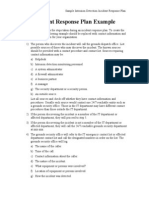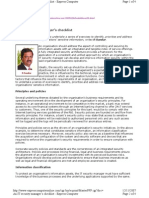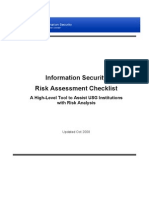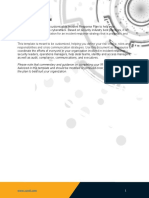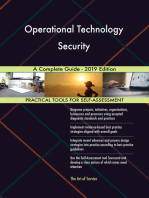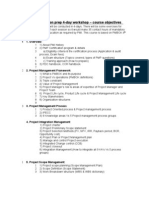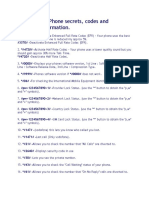Security Hardening Notes
Security Hardening Notes
Uploaded by
sahajCopyright:
Available Formats
Security Hardening Notes
Security Hardening Notes
Uploaded by
sahajCopyright
Available Formats
Share this document
Did you find this document useful?
Is this content inappropriate?
Copyright:
Available Formats
Security Hardening Notes
Security Hardening Notes
Uploaded by
sahajCopyright:
Available Formats
GS&F IS Guidance: Security Hardening
Security Hardening
Target Audience for this guidance
Technology Service Providers (TSPs): IT managers responsible for TSP policies, standards and processes Project and programme managers and teams System designers and software development teams IT Operations teams Information Security Functions (ISFs) Contract owners / contract managers who contract services, which include IT services, to third parties Business owners who commission or own any IT systems
What is included in this guidance
What is the objective of this guidance Security Hardening Who should do this When this should be done What needs to be done Where hardening should be applied What should be included in hardening
Management of a hardening programme References and additional guidance If you need more information
Procedural Guidelines Section 5 Communications and Operations Security, specifically 5.1.4c Section 6 Access Control, specifically 6.5.3g Section 7 Systems Acquisition, Development and Maintenance
What is the objective of this guidance
The objective of this guidance is to ensure that systems are developed with good security so that the risks to Group Information and its supporting systems and infrastructure are controlled. It does this by explaining the concept of security hardening and its importance, and providing additional information to support the understanding of control statements 5.1.4c and 6.5.3g in the GS&F Information Security Procedural Guidelines. It links this to relevant parts of sections 5, 6 and 7, of the Guidelines, and other GS&F IS Guidance available. It also defines an approach for addressing the Procedural Guideline requirements, explaining where security hardening should be applied, what should be included, and how it should be managed. This should assist TSPs develop and manage an effective hardening programme. It is acknowledged that this approach may not represent an optimum solution for all Divisions and Business Units in the Group, and there may be other valid approaches. However, where an alternative approach is adopted it must ensure compliance with Procedural Guidelines.
Version 1.0
Page 1 of 6
GS&F IS Guidance: Security Hardening
Security Hardening
Security hardening is the process of configuring a computer system in a secure way so that it is hardened and resistant against attack. The purpose is to eliminate as many security vulnerabilities as possible, so reducing the opportunities for attack. Most Out of the Box computer software and systems have a very weak security configuration and default settings to make them easy to use. Before they can be deployed into production they must be security hardened. Security hardening provides an additional layer of protection for services based on the security principle of defence-in-depth. Hardening can make a system less vulnerable to compromise in an attack. It can also limit the amount of damage an attacker can do, and be the last line of defence in the event of a security compromise. For example, if a malicious user is able to penetrate the Groups perimeter defences, a hardened server can provide the final layer of security for information assets on internal systems. It is important to note that hardening is not a panacea for security. It is just another layer in a good security model. Any system that is accessible on a network and running services can potentially be attacked. It then only takes a single vulnerability to successfully breach the security and compromise the information. Security hardening should be a key component in securing IT systems.
Who should do this
Technology Service Providers (TSPs): IT managers responsible for TSP policies, standards and processes Project and programme managers and teams System designers and software development teams IT Operations teams Information Security Functions (ISFs) Contract owners / contract managers who contract services, which include IT services, to third parties Business owners who commission or own any IT systems
When should this be done
Security hardening should be completed and validated prior to any system going into production and during any major change. It should be validated during periodic checks and reviews. These requirements should be incorporated in all applicable IT policies, processes and standards when they are being drafted. In addition, they must also be addressed: When a new IT architecture and design standard is being established. Upon rollout of any new operating system or version. Upon deployment of any new middleware or versions. If new software (off the shelf or custom) or equipment is selected. If an IT system and project is not following a standard approved architecture and build.
What needs to be done
Security hardening processes and associated guides and build standards must be implemented by TSPs in the Group, and when IT services are outsourced to third party providers. This should include a security hardening programme/process and
Version 1.0 Page 2 of 6
GS&F IS Guidance: Security Hardening
hardening guides to support all systems within their environments. The hardening guides should be updated as new information is received about new vulnerabilities and threats (please see GS&F IS Guidance on Vulnerability Management for more information).
Where hardening should be applied
Hardening should be applied to base system builds which are to be deployed into production. This should include operating systems and any middleware such as databases. It is recommended that most applications are also hardened, although the extent that this is required is likely to vary. Hardening is particularly important for all computers and devices that are public facing, and for security and network devices. The hardening standards that are applied to these should be particularly rigorous. Guides and processes for hardening should include the following types of system: File Servers Print Servers Application Servers Email Servers Web Servers Authentication Servers Network Devices (Switches, Routers, Load balancers) Security Devices (Firewalls, IDS, IPS) Workstations Mobile Computing Devices (Blackberry, PDAs, Cell Phones) Middleware such as databases Applications Systems in development and test environments do not normally need to be security hardened, provided they are properly segregated from production (please see GS&F IS Guidance on Development, Test and Production Facilities). However, it may be beneficial to harden these as well. It is recommended that systems used in test have hardening applied to ease their deployment. Otherwise it may well be found that systems that have functioned perfectly in test suddenly fail to work when moved to pre-production or production. Hardening should also always be applied to like-live systems.
What should be included in hardening
One of the first things to consider when developing hardening guides are the different roles that servers and other types of computer equipment will have. The hardening criteria (or policy) that are applied should depend on the role. One of the reasons for this is that during hardening all services and software that are not required are disabled or removed, and what is required will obviously depend on the role. For example an Email server would not normally require any Web services. Hardening therefore needs to consider roles, and a generic hardening standard which applies the same criteria for all types of server will not provide a sufficient level of security. Typical roles used in hardening include (please note this is not a complete list): Gateway Firewall Application Firewall Core switch
Version 1.0 Page 3 of 6
GS&F IS Guidance: Security Hardening
Access switch Web server, Database server Mail server DNS server File server FTP server DHCP server Application server or other limited purpose servers, for example: web application server, like Websphere SAP/R3 server
Developing System hardening guides by roles adds specific hardening based on the service/s the system is running. It removes unnecessary services and vulnerabilities by only allowing the services that are necessary for the system based on function and role. Security hardening will also depend enormously on the type, make and version of the operating system and other software. For example, specific hardening guides will be required for each type and version of the Windows operating system. Similarly, each type, variety and version of Unix will require a specific guide. There are many areas that should normally be addressed when hardening a system. These include the following: Disabling unused software and services System utilities that are capable of overriding or changing system and application controls must be removed if not required (5.1.4c and 6.5.3g). Utilities can range from stand-alone software to services that are included and are shipped with operating systems, middleware and applications. If they are considered to be required then their use must be reviewed on an annual basis by an Information Security Function and: access must be logically controlled allocated to a role, with usage auditable controlled by a process that restricts the usage of such utilities to the minimum required number of users subject to individual user identification, authentication, and authorisation. Unnecessary services, protocols & daemons should be removed or disabled. Features not required in services should be turned off. Only the essential applications, applets and scripts necessary for the system functionality should be installed. Installation of software patches and hotfixes Please see GS&F IS guidance on Vulnerability Management. Authentication and Access control. Authentication techniques and configuration, such as password policies and enforcing strong passwords Configuration of logon banners User rights assignment (least privileged access) and role based access Configuring permissions and access to files and data volumes Segregation of duties Disabling and/or renaming of default and unused system accounts
Version 1.0 Page 4 of 6
GS&F IS Guidance: Security Hardening
Restricting powerful accounts Set registry permissions Configuring access to the system via local group and user accounts Install and configure any network access control required including any local firewalls, and network port settings Please see GS&F IS Guidance on Access Control for details. Installation and configuration of anti-virus and anti-malware software Please see GS&F IS Guidance on Malicious Code and Mobile Code Protection. Installation and configuration of any encryption required Key management settings e.g Kerberos policies Disk encryption VPNs Please see GS&F IS Guidance on Cryptography Configuring audit logging, monitoring and alerting What to log and monitor Log settings Implementation of real-time exception reporting Install and configure any intrusion detection and/or prevention software Please see GS&F IS Guidance on Auditing and Monitoring.
Management of a hardening programme
Hardening guides and processes should be developed as discussed. However, to properly manage a hardening programme a number of processes are required. These include: The development of hardening guides and processes, including specific security configurations and baseline installations. Processes to identify and review system vulnerabilities and threats on an ongoing basis, and to incorporate the findings into the hardening guides as required. Processes to continually manage and enhance the hardening guides. Integration into the System Development Life Cycle and change processes (please see the GS&F IS Guidance on Information Security in the System Development Lifecycle), and continuous improvement programs. Development of configuration checks and checklists to test compliance to the hardening Guides. Deployment of vulnerability scanning (please see the GS&F IS Vulnerability Scanning Framework).
References and additional guidance
GS&F IS Guidance documents referenced: GS&F IS guidance on Vulnerability Management GS&F IS Guidance on Access Control GS&F IS Guidance on Malicious Code and Mobile Code Protection GS&F IS Guidance on Cryptography
Page 5 of 6
Version 1.0
GS&F IS Guidance: Security Hardening
GS&F IS Guidance on Auditing and Monitoring GS&F IS Guidance on Information Security in the System Development Lifecycle GS&F IS Vulnerability Scanning Framework.
Many product vendors, security organisations and some government agencies have committed resources to developing standards for security hardening. It is strongly recommended that those charged with managing security hardening programmes use these as references for developing specific guides for use within the Group. The following Websites provide examples and are recommended: US, National Security Agency (NSA) has the most extensive library on Hardening Standards. http://www.nsa.gov/snac/ US, National Institute of Standards and technology (NIST) Security Configuration. http://csrc.nist.gov/checklists/repository/vendor.html DISA Security Technical Implementation Guides (STIGS). http://iase.disa.mil/stigs/index.html
If you need more information
Please contact GS&F Information Security via email ~ GS&F Information Security or phone +44 (0) 131 523 2144 (internal: 222144) if you need more information.
Version 1.0
Page 6 of 6
You might also like
- Ball and Beam Courseware Sample For MATLAB UsersDocument10 pagesBall and Beam Courseware Sample For MATLAB UsersÖzgürErbulan100% (1)
- Blue Star Chiller Air & Water Cooled Screw Chiller R22 DX ManualDocument123 pagesBlue Star Chiller Air & Water Cooled Screw Chiller R22 DX ManualAwdhesh Singh Bhadoriya72% (36)
- Incident Response Plan ExampleDocument4 pagesIncident Response Plan ExampleNelson Ivan Acosta100% (3)
- Operationalizing Information Security: Putting the Top 10 SIEM Best Practices to WorkFrom EverandOperationalizing Information Security: Putting the Top 10 SIEM Best Practices to WorkNo ratings yet
- Information Security PlanDocument11 pagesInformation Security PlanJohn J. Macasio100% (1)
- TEMPLATE Information Security Awareness and Training PolicyDocument3 pagesTEMPLATE Information Security Awareness and Training PolicyDahianna Ramírez50% (2)
- Information Security Risk Assessment Services BriefDocument2 pagesInformation Security Risk Assessment Services BriefAK2024100% (1)
- Cyber Risk Management FrameworkDocument9 pagesCyber Risk Management Frameworkleo588050% (2)
- Cloud Penetration TestingDocument20 pagesCloud Penetration TestingchrismorleyNo ratings yet
- Protecting Information From Insider Threats: Solution GuideDocument4 pagesProtecting Information From Insider Threats: Solution GuidesecuritybeepNo ratings yet
- SOW SecurityDocument3 pagesSOW SecurityJohn Croson100% (2)
- IT Policy: Information Technology ManualsDocument18 pagesIT Policy: Information Technology Manualsdes_troyer_84100% (1)
- Cybersecurity Assesment Tool-1Document18 pagesCybersecurity Assesment Tool-1Mike DeeNo ratings yet
- Information Security - AwarenessDocument50 pagesInformation Security - AwarenessMoiz UddinNo ratings yet
- Enterprise DLP As A Program - Phase 1: Project Charter: WhitepaperDocument6 pagesEnterprise DLP As A Program - Phase 1: Project Charter: WhitepaperChandrashekar M0% (1)
- An IT Security Manager's ChecklistDocument4 pagesAn IT Security Manager's Checklistrajunair0% (1)
- Essential 8Document8 pagesEssential 8Fahad HasanNo ratings yet
- APPLICATION SECURITY ASSESSMENT - Draft - Ver01Document42 pagesAPPLICATION SECURITY ASSESSMENT - Draft - Ver01An LeNo ratings yet
- BSIMM V ActivitiesDocument32 pagesBSIMM V ActivitiesmabesninaNo ratings yet
- Mobile Device Acceptable Use Policy TEMPLATEDocument8 pagesMobile Device Acceptable Use Policy TEMPLATEDriveStrike The Smart ChoiceNo ratings yet
- Incident Response Plan TemplateDocument12 pagesIncident Response Plan Templatechidseymatt100% (4)
- Security Awareness TrainingDocument17 pagesSecurity Awareness Traininginnocent100% (1)
- 014 Information Cyber Security Policy V1.0Document27 pages014 Information Cyber Security Policy V1.0Yao Xia LiNo ratings yet
- Comparison of It Security StandardsDocument65 pagesComparison of It Security StandardsSpeedoorlock100% (1)
- Security Policy 02Document3 pagesSecurity Policy 02prabir_kalna5601100% (1)
- Security Assessment and TestingDocument43 pagesSecurity Assessment and TestingZulfikar100% (1)
- Anti-Virus and Anti-Malware Policy - V2Document10 pagesAnti-Virus and Anti-Malware Policy - V2penumudi233No ratings yet
- Perations Ecurity Olicy: Inspiring Business InnovationDocument20 pagesPerations Ecurity Olicy: Inspiring Business InnovationrontechtipsNo ratings yet
- Cyber Security Employee Awareness Training Program PDFDocument12 pagesCyber Security Employee Awareness Training Program PDFAnonymous 2WKRBqFlf50% (2)
- Security Implementation Plan - nts201 DileyDocument13 pagesSecurity Implementation Plan - nts201 Dileyapi-308999719No ratings yet
- Byod PolicyDocument1 pageByod Policyapi-231740456No ratings yet
- Information Security Incident ManagementDocument8 pagesInformation Security Incident ManagementcaliagarNo ratings yet
- Database Security Application Checklist TemplateDocument3 pagesDatabase Security Application Checklist TemplateIvan Estuardo Echeverría CatalánNo ratings yet
- Innovatum DLP WPDocument9 pagesInnovatum DLP WPlittlepaoNo ratings yet
- Kaspersky Security Awareness Training BrochureDocument10 pagesKaspersky Security Awareness Training Brochurematar LONo ratings yet
- Bru Cyber Security ChecklistDocument12 pagesBru Cyber Security ChecklistpopsalldayNo ratings yet
- AIS Incident Response ProcedureDocument33 pagesAIS Incident Response ProcedureAditya VijayNo ratings yet
- Incident Response GuideDocument10 pagesIncident Response GuideRapacitorNo ratings yet
- Introduction To Enterprise Data ManagementDocument5 pagesIntroduction To Enterprise Data ManagementBenz ChoiNo ratings yet
- Malware Incident ResponseDocument6 pagesMalware Incident Responsectbaby1No ratings yet
- Frameworks and Assessment ToolsDocument2 pagesFrameworks and Assessment ToolstdigitsNo ratings yet
- Cyber Security AwarenessDocument6 pagesCyber Security AwarenessArya Adhi Nugraha100% (1)
- Tracking Security Awareness KPIsDocument10 pagesTracking Security Awareness KPIstallraj100% (1)
- Patch Management Check IT ListDocument23 pagesPatch Management Check IT ListCourtney JohnsonNo ratings yet
- Threat HuntingDocument2 pagesThreat HuntingrajeshNo ratings yet
- Checklist Web Application SecurityDocument2 pagesChecklist Web Application SecurityZoltán BalázsNo ratings yet
- Information Security Policy PDFDocument98 pagesInformation Security Policy PDFjohn paro100% (2)
- Information Security PlanningDocument8 pagesInformation Security PlanningSamuel WagemaNo ratings yet
- USG Risk Assessment ChecklistDocument7 pagesUSG Risk Assessment ChecklistShady Al-SeuriNo ratings yet
- Security GovernanceDocument5 pagesSecurity GovernanceQaiser KhanNo ratings yet
- Best Practices For Data Loss Prevention (DLP) WebSenseDocument4 pagesBest Practices For Data Loss Prevention (DLP) WebSenseDani Kirky YlaganNo ratings yet
- Security Control Categories and Types FactsDocument2 pagesSecurity Control Categories and Types FactsВіталій ІванюкNo ratings yet
- Policy Security SettingDocument17 pagesPolicy Security Settingmango1812100% (1)
- Web Application Security Checklist 1685278378Document32 pagesWeb Application Security Checklist 1685278378Medhat Wasel100% (1)
- ATA PlaybookDocument40 pagesATA PlaybookAaronTNo ratings yet
- Cybersecurity and Physical Security ConvergenceDocument4 pagesCybersecurity and Physical Security ConvergenceDavid F MartinezNo ratings yet
- IR Plan TemplateDocument16 pagesIR Plan Templatekkkk_2100% (1)
- How To Conduct A Risk AssessmentDocument23 pagesHow To Conduct A Risk Assessmentdurgasainath100% (1)
- CIS Excel Compliance OverviewDocument5 pagesCIS Excel Compliance OverviewChristNo ratings yet
- Operational Technology Security A Complete Guide - 2019 EditionFrom EverandOperational Technology Security A Complete Guide - 2019 EditionNo ratings yet
- Are We Doing Well SlidesDocument10 pagesAre We Doing Well SlidessahajNo ratings yet
- Javamagazine20130304 DLDocument78 pagesJavamagazine20130304 DLjavadev_ruNo ratings yet
- Software Testing MethodsDocument45 pagesSoftware Testing MethodssahajNo ratings yet
- Icon NMR ManualDocument181 pagesIcon NMR ManualsahajNo ratings yet
- PMP Certification - 4daysDocument4 pagesPMP Certification - 4dayssahajNo ratings yet
- Nokia Mobile Phone SecretsDocument11 pagesNokia Mobile Phone SecretssahajNo ratings yet
- WSC2022SE TP09 S1 Actual enDocument11 pagesWSC2022SE TP09 S1 Actual enilmi56No ratings yet
- 2G Internet Packages - GrameenphoneDocument4 pages2G Internet Packages - GrameenphoneisanNo ratings yet
- Xiaomi Redmi Note 10 Pro Smartphone User GuideDocument105 pagesXiaomi Redmi Note 10 Pro Smartphone User GuideAsaad ChughtaiNo ratings yet
- ADMINISTRATOR SCMS Vacant PositionsDocument8 pagesADMINISTRATOR SCMS Vacant PositionsnormanNo ratings yet
- Firewall ReportDocument101 pagesFirewall Reportringku2k100% (4)
- EMBEDDED SYSTEM LAB TRAINER Instruction ManualDocument27 pagesEMBEDDED SYSTEM LAB TRAINER Instruction ManualyogeshNo ratings yet
- Creating Intuitive Interactive Dashboards With The Adf Data Visualization ComponentsDocument74 pagesCreating Intuitive Interactive Dashboards With The Adf Data Visualization ComponentsnandhulnNo ratings yet
- Water Mist Fire Protection Reliability Analysis: Shuzhen Xu David FullerDocument6 pagesWater Mist Fire Protection Reliability Analysis: Shuzhen Xu David FullerMarie DoloresNo ratings yet
- Agro-Rural Development As A Source of Socio-Economic Change With Special Reference To IranDocument8 pagesAgro-Rural Development As A Source of Socio-Economic Change With Special Reference To IranAmin MojiriNo ratings yet
- Lesson No. 13 Visual Information and MediaDocument2 pagesLesson No. 13 Visual Information and MediaRelox, Kenth Gabriel R.No ratings yet
- Formulir Checklist Pemeriksaan Mobile CraneDocument7 pagesFormulir Checklist Pemeriksaan Mobile CraneEdwin RajagukgukNo ratings yet
- Reporte CompletoDocument57 pagesReporte Completoutranetflix2020No ratings yet
- 2017-01 ALEXAMini Sample Footage Technical InformationDocument5 pages2017-01 ALEXAMini Sample Footage Technical InformationAlexandreNo ratings yet
- Operacion y Mantenimiento Cargador Doosan dl320 02Document11 pagesOperacion y Mantenimiento Cargador Doosan dl320 02kzarate.crybNo ratings yet
- Vt7D / Vt7Ds: High Performance Vane PumpDocument2 pagesVt7D / Vt7Ds: High Performance Vane PumpNazir Ahmed ShaikhNo ratings yet
- Service Manual Marine EnginesDocument95 pagesService Manual Marine Engineslexxa3210% (1)
- 2.instrumentation AmplifierDocument6 pages2.instrumentation Amplifiersuresh151971No ratings yet
- EE303 OutlineDocument3 pagesEE303 OutlineRay WongNo ratings yet
- Noti. No. 04-2014 C.E.Document4 pagesNoti. No. 04-2014 C.E.Ashutosh GargNo ratings yet
- Teaching FactoryDocument11 pagesTeaching Factoryjipenx_sagaNo ratings yet
- THYRISTORDocument6 pagesTHYRISTORLim YorkChuanNo ratings yet
- Barcoding InformaticsDocument10 pagesBarcoding Informaticsapi-650274498No ratings yet
- CMSS 6155 W Optical Phase Reference Kit PDFDocument4 pagesCMSS 6155 W Optical Phase Reference Kit PDFHector MaldonadoNo ratings yet
- Oracle SQL Developer Users GuideDocument522 pagesOracle SQL Developer Users Guideماجد الحميديNo ratings yet
- Trainer Profile - Kartavya JainDocument2 pagesTrainer Profile - Kartavya JainkartavyajainNo ratings yet
- Spectrum LSF 10.1.0 DocumentationDocument3,087 pagesSpectrum LSF 10.1.0 Documentationtomyyy2No ratings yet
- Specification: FOR ApprovalDocument41 pagesSpecification: FOR ApprovalGiovanni DucardNo ratings yet
- Report NewDocument22 pagesReport NewYNo ratings yet


